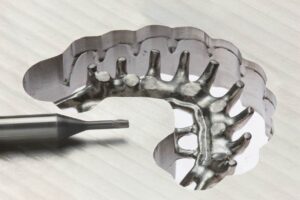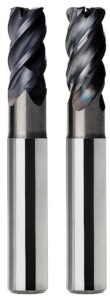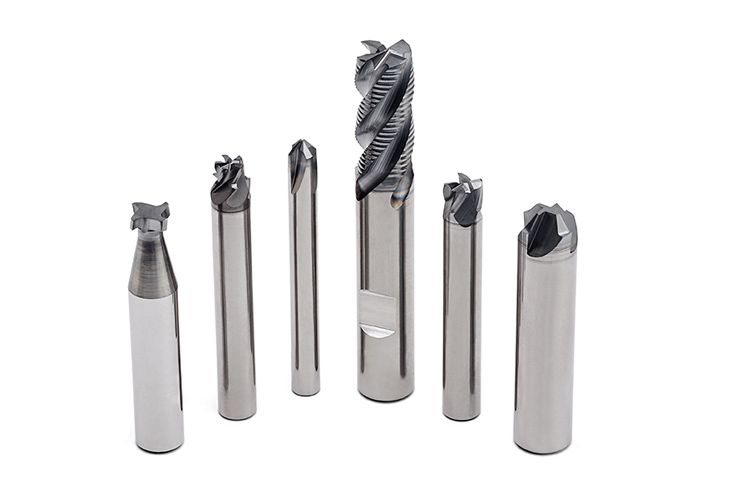Innovative engineering and technology drive continuing progress in the critical industries of medical, power generation and aerospace part production. Manufacture of the precision components made in those industries requires workpiece materials that provide high resistance to heat and wear, extreme toughness, and unwavering quality and reliability. Prime examples of those materials are ISO-S alloys, namely nickel-, cobalt- and iron-based heat resistant superalloys (HRSA), and titaniums. The hot hardness, strength and creep and corrosion resistance of these materials prompt their use in a wide range of crucial applications.
The alloys’ beneficial properties, however, also produce machining characteristics different than those of traditional irons and steels. Machining ISO-S materials is challenging because alloys transfer heat poorly, also known as low thermal conductivity. The heat generated in machining (~1100 degrees Celsius to 1300 degrees Celsius) is absorbed by the tool and workpiece instead of being carried away in the cut chips. Thereby, tool life suffers, and part distortion can occur. The alloys also have tendencies to strain and precipitation harden when machined, increasing cutting forces and further degrading tool life. Lastly, the sticky behaviour of these materials creates uncontrolled built-up edge (BUE) and notch wear. Such stickiness is also known as a material’s ductility, a characteristic common in soft materials such as aluminium.
Considering the difficulty of machining ISO-S materials and the expense of the parts involved, manufacturers pursue machining improvements that primarily focus on component reliability and quality, with cycle time reductions coming in as a second priority. Maximising the benefits of these high-performance alloys requires the use of advanced tools and application strategies. Toolmakers fine-tune those tools and techniques to provide productive and reliable solutions for specific industry applications.
Medical applications
To function properly and avoid rejection by the body, a medical implant must be chemically inert and fully resistant to corrosion by bodily fluids. Accordingly, the biocompatibility and corrosion resistance of ISO-S materials make them an excellent basis for a wide range of orthopedic, dental, and other medical components.
Manufacturing of medical implants is growing rapidly. The average age of the population of industrialised areas is moving higher, and so is the population’s average weight. Both factors have direct implications for wear of knee and hip joints and resulting demand for replacements. The popularity of dental implants has also grown in line with increased attention on cosmetic and dental health issues.
Replacement knee components
Two basic components make up a replacement knee. The femoral component imitates the round condyle prominence at the end of the thigh bone and attaches to the upper leg bone or femur. In turn, the femoral component bears on a polymer cup that rests in the second basic component, a titanium tray that is attached to the top of the lower leg bone or tibia.
The poor heat transfer properties of ISO-S materials mandates the use of coolant in most machining operations. However, medical regulators have strict rules regarding contamination by residual coolant and demand stringent and time-consuming cleaning processes. As a result, toolmakers are developing ways to machine medical parts “dry,” without coolant or emulsion. Seco, for example, has developed coolant-free processes to machine Ti6Al4V titanium tibal trays with special t-slot and form end mills. The operation is complete in less than 10 minutes, with good tool life, excellent product quality, and contamination-free parts.

The Jabro tool assortment, which includes four custom and two standard solutions, is well suited for medical part manufacturers processing tibial tray components.
To solve the problem, Seco application engineers developed a five-step method to machine femoral components on a machining center. The process uses ball end mills and a part fixture with a centerlock system that permits the part to be rotated during machining. This copy milling approach is well suited for less rigid part-clamping setups, which are often the case when producing these complex 3D parts. Cutting time for the entire operation is about seven minutes. After machining, only a polishing operation is required, and that polishing process consumes less time than the polishing previously performed after grinding.
Small dental parts
Specialised machining methods can help overcome the challenges of machining ISO-S materials. High feed milling strategies (see sidebar) provide productivity combined with long tool life. In a roughing operation on a dental component made of CoCr steel, a 3mm-diameter JHF 180 cutter from Seco’s Jabro endmill line was applied at a table feed rate of 4,000mm/min with a 2mm axial depth of cut, 0.2mm radial depth of cut, and cutting speed of 66 m/min. In the cobalt-chrome steel, tool life was 175 minutes.
 Many small medical and dental components are machined on compact high-speed machining centers in laboratories and dental offices. The small cutters these machines employ must be engineered to withstand the rapidly changing chip loads characteristic of profiling operations on small implants and other parts. To fill that need, Seco developed Jabro Mini JM905 and JM920 cutters. The tools are available in 4-flute versions in diameters from 0.1mm to 2.0mm, and in long overhang lengths up to 16 x D. Despite their small size, the tools offer the strength and stability required for specialised small-part production, with dimensions that meet typical workpiece requirements.
Many small medical and dental components are machined on compact high-speed machining centers in laboratories and dental offices. The small cutters these machines employ must be engineered to withstand the rapidly changing chip loads characteristic of profiling operations on small implants and other parts. To fill that need, Seco developed Jabro Mini JM905 and JM920 cutters. The tools are available in 4-flute versions in diameters from 0.1mm to 2.0mm, and in long overhang lengths up to 16 x D. Despite their small size, the tools offer the strength and stability required for specialised small-part production, with dimensions that meet typical workpiece requirements.
Power generation
ISO-S materials are also finding increased application in the global power generation industry. Despite current emphasis on “green” energy sources such as wind, water, and solar, over 60 percent of the world’s electric power is currently produced via combustible fuels. The majority of that power production involves the use of gas and steam turbines. In addition, there are ongoing efforts to make the turbines more efficient. Strong, yet lightweight titanium components, for example, reduce centripetal forces at high rotations per minute in the lower compression sections of the turbines, resulting in faster rotational speeds. In addition to titanium components, HRSA parts are used in the combustion sections to handle the increased temperatures necessary for higher engine efficiency.
Newer alloys, greater challenges
In the pursuit of efficiency and increased performance, ISO-S alloys undergo constant evolution. Metals producers develop alloys with greater capabilities to meet the demands of increasingly tougher applications. For example, established HRSA such as nickel-base Inconel 738 and cobalt-based SFX414 were engineered to operate in temperatures in the range of 850 degrees Celsius to 1200 degrees Celsius. Some of the latest HRSA compositions such as GTD 262 and Rene 108 are intended to perform at temperatures of 1200 degrees Celsius to 1600 degrees Celsius. The new alloys present proportionately greater machining challenges.
Seco recently assisted with the machining of a new, higher-performance alloy used in static components of a power generation turbine. With the material’s higher heat resistance came increased machining difficulty; only 18 m/min cutting speed could be achieved, compared to a speed of 25-35 m/min typical with Inconel 718 reference material.
Existing tooling wore out after only one turbine segment (320mm cutting length), and the turbine manufacturer sought greater tool life. Seco developed a special cutter based on the Jabro 780 tool geometry, which features a dual-core design that provides increased stability in tough cutting conditions. The tool was applied at the parameters used originally: cutting speed of 18 m/min, feed per tooth of 0.015mm and table feed of 43 mm/min. The new tool machined two turbine segments (640 mm), an increase of 100 percent in tool life. Then, by reducing cutting speed to 16 m/min. and increasing feed per tooth 0.017mm, application engineers were able to further extend tool life to 800 mm (+ 150 percent tool life).
Aerospace components
Because HRSA maintain strength at high temperatures and offer superior creep and corrosion resistance, the alloys make up as much as 50 percent of the weight of a modern aerospace engine.
Applications of ISO-S materials in aerospace turbines are similar to those in turbines used in energy production. In many cases, however, aerospace tolerances are tighter. For example, Seco develops special tools to machine the fir-tree-shaped root profile of turbine blades. Root profile tolerances for some energy applications are in the range of 10 microns, while tolerances for some aerospace profiles are as tight as 0-5 microns (0. – 0.005).
Structural titanium
In addition to application in the low-temperature sections of turbines, titanium’s light weight and strength is exploited in structural aerospace parts such as landing gears. By nature the landing gear components are massive and strong, but also very heavy when manufactured from standard materials.
Newer, lighter and stronger titanium alloys used to produce lighter landing gears are more difficult to machine than the titanium alloys previously applied. One such recently developed alloy is titanium 5553, so called because it includes 5 percent aluminium, 5 percent molybdenum, 5 percent vanadium, and 3 percent chromium content. The benefit of titanium 5553 is its high tensile strength: 1160 MPa compared to 910 MPa for Ti6Al4V reference material. The higher tensile strength limits cutting speeds to levels 50 percent lower than those applied with Ti6Al4V.
Stacked alloys
If a single ISO-S material poses machining difficulty, processing two different materials together offers an even greater challenge. Some aerospace applications involve machining components composed of stacks of differing materials. The challenge is to machine the “sandwich” or “hybrid” with adequate chip control and no vibration or burrs.
A typical example would be a combination of titanium and stainless steel. Stainless steel and titanium do share some properties; both are relatively high in strength and have adhesive properties in that the cut material tends to stick to the endmill.

Seco’s solution for machining an engine mount featuring a titanium 6Al4V/austentic stainless steel stack was application of a carbide Jabro JHP 770 tool specially designed for machining titanium. The tool incorporates differential flute spacing, radial relief and a specially formed chip space. A through-coolant channel minimises workpiece adhesion and clears chips. In machining the stacked materials, the tool passed first through the stainless steel then through the titanium. The parameters for more difficult-to-machine material (titanium) were applied throughout. In recognition of the alloy’s low thermal conductivity, a moderate cutting speed of 50 m/min was used, with a feed of 0.036mm/rev feed, and a 3mm depth of cut, descending in circular interpolation.
HSS alternative
Despite its performance advantages in many situations, carbide tooling is not the only way to effectively machine ISO-S materials. In some cases, high-speed steel cutters are a more productive and cost-effective choice.
Many large aerospace components, such as landing gear parts, are machined from solid billets of titanium or stainless steel. For these parts, high-performance HSS tools up to 50mm in diameter are capable of removing large volumes of material. The HSS tools are very effective on low-rpm, high-torque machines for effective roughing and even finishing of titaniums and stainless steel. The ability to employ large diameters and widths of cut enables the tools to provide competitive metal removal rates even when run at lower speeds than those achievable with carbide tools.

An example of an advanced HSS tool is the Jabro JCO710 HSS-Co cutter with 8 percent cobalt content and a hardness of 67 HRC. The tool features polished flutes to reduce friction and edge build-up, and a variable face profile geometry to cut light and reduce the risk of chatter that causes unacceptable surface roughness values. These cutters have provided more than 800 minutes of tool life when applied at a manufacturer producing large titanium parts.
Conclusion
Manufacturers’ goals for machining operations for ISO-S materials used in critical applications are top quality, reliable consistency, and productivity. As metal producers develop new alloys to meet increasingly demanding high-performance applications, cutting tool makers in turn create new cutting tool materials and strategies engineered to overcome the machining challenges of ISO-S materials and enable manufacturers to meet their machining goals.
Sidebar
ISO-S milling strategies
Carefully engineered combinations of tools and cutting strategies facilitate productive and cost-effective machining of ISO-S materials.
One approach is high-feed milling, a method that transfers cutting forces from the radial to the axial direction, combining small axial depths of cut with high table feeds. The technique produces a thinner chip that carries the heat away from the cutting edge and reduces cutting forces, minimising vibration and stabilising the machining operation. In addition to reducing the generation of heat and extending tool life, high-feed milling also provides a high metal removal rates: up to 200 – 300 percent faster than traditional milling.
High-feed milling can be employed with a variety of tools. From its global Jabro endmill line, for example, Seco offers JHF180 tools that are designed for machining harder steels and cobalt chrome alloys in the 48 – 62 HRC range. The tools feature a rigid 0.9-degree tapered neck design that reduces tool deflection, enables deep cavity milling, and improves surface finish. Tool geometry is designed to eject the chips away from the cutting edge. They are suitable for high-feed milling applications including face milling, slotting, ramping, helical interpolation, ramping and Z-level machining.
Other strategies for milling ISO-S materials depend on the specific operation, workpiece material, and machine at hand. A conventional approach involves a 1-1 balance of axial and radial depth of cut and average feed rates. High-performance machining, carried out with specialised cutters such as Seco’s HPM line, utilises large axial depths of cut and full-width radial depths of cut to achieve large metal removal volumes. High-speed machining is another alternative, where the cutter runs at fairly low radial depths of cut and large axial depths of cut. This approach permits use of higher cutting speeds to gain productivity. Effective implementation of the differing machining strategies depends on a combination of factors including the capabilities of the machine tool in use as well as the CNC system that will handle the large programs and files required to carry out the machining processes.
Titanium machining has its own set of specialised operating and tooling requirements. Use of moderate cutting speeds helps avoid generation of excessive heat that can promote chemical reactions between the tool and the workpiece. Coolant should be applied whenever possible. Sharp cutting edges reduce cutting forces by facilitating shearing of chips from the workpiece. High-feed strategies apply here as well.
About Author:
Teun van Asten MSc., Engineer Marketing Services Solid Milling, Seco Tools



